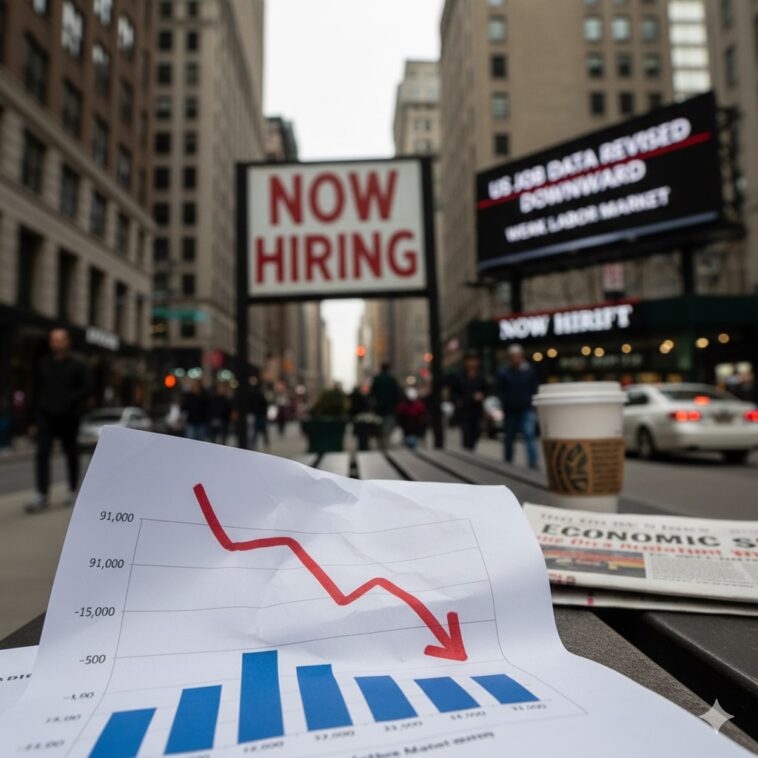The latest US employment data just took a surprising turn. Today, the Bureau of Labor Statistics (BLS) dropped a major revision, revealing that the U.S. economy actually employed 911,000 fewer people than we previously thought back in March 2025. This isn’t just a minor adjustment; it’s a significant shift in how we view the labor market, indicating a serious downturn that many economists missed until now.
For months, we’ve been led to believe that the job market was strong, a solid foundation supporting a shaky economy. But this new information suggests that image was more of an illusion. It’s a real wake-up call, and a pretty jarring one at that.
A Sizable Correction, With Political Fallout to Follow
The recent revision looking back from March 2024 to March 2025 is more than just a technical tweak. It nearly cuts the average monthly job gains in half, dropping the figure from 147,000 to just 71,000. This marks a significant moment—a surprising 0.6% decrease from the previous estimate, which is well above the usual 0.2% average revision the BLS has observed over the last ten years.
Such corrections don’t occur in isolation. They directly influence political discussions, especially in light of the growing divide over the trustworthiness of government data. Critics are quick to point out the trend of these revisions often being on the optimistic side. The last major annual revision, released during a contentious presidential campaign, reduced the job count by 818,000. This new data, even more substantial, is bound to heighten the scrutiny.
“This isn’t merely a statistical anomaly; it’s a significant shift in how we should perceive the economy’s momentum over the past year,” remarked Maria Sanchez, a senior economist at Meridian Group. “It indicates that the job market—the engine of the economy—was operating with far less fuel than we previously believed.”
Where Did All the Jobs Go?
The bulk of the jobs that have disappeared were in the private sector, with a shocking 880,000 fewer positions than we initially thought. Only 31,000 of those lost jobs were in government. The biggest downward adjustments were seen in two main areas:
– Leisure and Hospitality: A loss of 176,000 jobs.
– Professional and Business Services: A decline of 158,000 positions.
This isn’t exactly shocking. These sectors are often the first to react to economic changes, much like a canary in a coal mine. When consumers and businesses start to tighten their belts, these industries feel the pinch first. The revisions indicate that this pullback has likely been happening for some time, even while other indicators appeared stable.
A Political Firestorm in the Making
The political tension is already heating up. President Trump, who has previously labeled the BLS’s numbers as “phony” and even dismissed the agency’s commissioner, now has new ammunition to work with. This data allows the administration to argue that the economy was faltering long before he took office, effectively shifting the blame for the current slowdown away from his own policies.
The President has frequently taken aim at Federal Reserve Chair Jerome Powell, claiming he’s been “too late” with his policy decisions. With this new data indicating a cooling economy much earlier than previously believed, those criticisms are only going to gain more traction.
This controversy isn’t going away anytime soon. The final, official numbers for this period won’t be available until February 2026. In the meantime, the political battle lines are firmly drawn, and the debate over the reliability of government data is likely to dominate the headlines for a while. The President’s controversial choice for the new BLS commissioner, E.J. Antoni—a known critic of the agency—now has fresh evidence to support his call for a complete overhaul.
“The bottom line is that this new data has fundamentally changed our economic landscape,” said Michael Chen, a market strategist at Global Equities Group. “Policymakers, from the White House to the Federal Reserve, will need to rethink their entire strategy. The road ahead looks very different today than it did just yesterday.”



